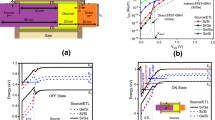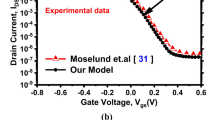Abstract
Tunnel field-effect transistors have demonstrated a predominant performance in the field of semiconductors. However, low drive current and ambipolarity are major challenges for TFETs. To overcome these challenges, a Partially Extended Germaniumn source DG-TFET (PEGeDG-TFET) is proposed. This PEGeDG-TFET structure has a partially extended Ge source under the gate below the Si-epitaxial layer to improve vertical tunneling, using the overlap area concept and pocket layer to enhance lateral tunneling along with suppressed Short-Channel effect. After scaling the transistor dimension up to 40%, the proposed device performance is not only retained but greatly improved by device engineering techniques. Further, a complete metal gate contact is deployed over the Si-epi layer length and overlapping the source metal-contact over oxide width touching Si-epi layer width. The proposed device study reveals the impact of source length, dielectric material, and oxide thickness variation. It also comprehends the impact of Ge molar fraction on transfer characteristics, transconductance, RF parameters (ft,GBP, etc). Further, the Linearity analysis in Si1−xGex source in PEDG-TFET with x varying from 0 to 1.The proposed device claims ION to be 3.2 mA/um, IOFF = 3.21 × 10− 17 A/um with an ION / IOFF ratio of 9.6 × 1013 along with enhanced transconductance, cut-off frequency, and gain-bandwidth product. The potential of the proposed device for digital logic applications are examined for the worst case (equal source and drain doping), and it is demonstrated in this work along with Analog/RF applications.
Similar content being viewed by others
Data Availability
All the data taken from another resource has been given the corresponding reference. The data, for which reference is not provided, is the original data.
References
Ratnesh RK, Goel A, Kaushik G, Garg H, Singh CM, Prasad B (2021) . Mater Sci Semicond Process 134:106002. https://doi.org/10.1016/j.mssp.2021.106002
Roy K, Mukhopadhyay S, Mahmoodi-Meimand H (2003) . Proc IEEE 91(2):305. https://doi.org/10.1109/JPROC.2002.808156
Taur Y, Buchanan D, Chen W, Frank D, Ismail K, Lo SH, Sai-Halasz G, Viswanathan R, Wann HJ, Wind S, Wong HS (1997) . Proc IEEE 85(4):486. https://doi.org/10.1109/5.573737
Raj B, Saxena A, Dasgupta S (2011) . IEEE Circ Syst Mag 11 (3):38. https://doi.org/10.1109/MCAS.2011.942068
Bala S, Khosla M (2018) . Superlattices Microstruct 124:160. https://doi.org/10.1016/j.spmi.2018.10.007
Thoti N, Lakshmi B (2017) . Mater Sci Semicond Process 71:304. https://doi.org/10.1016/j.mssp.2017.08.014
Kao KH, Verhulst AS, Vandenberghe WG, Soree B, Groeseneken G, De Meyer K (2012) . IEEE Trans Electron Devices 59(2):292. https://doi.org/10.1109/TED.2011.2175228
Bhuwalka KK, Schulze J, Eisele I (2005) IEEE Trans Electron Devices 52(5):909. https://doi.org/10.1109/TED.2005.846318
Raad BR, Nigam K, Sharma D, Kondekar PN (2016) . Superlattices Microstruct 94:138. https://doi.org/10.1016/j.spmi.2016.04.016
Acharya A, Solanki AB, Glass S, Zhao QT, Anand B (2019) . IEEE Trans Electron Devices 66(9):4081. https://doi.org/10.1109/TED.2019.2927001
Paras N, Chauhan SS (2019) . Microelectron Eng 216:111043. https://doi.org/10.1016/j.mee.2019.111043
Paras N, Chauhan SS (2019) Microelectron Eng 217. https://doi.org/10.1016/j.mee.2019.111103
Kr Singh O, Kaur B (2021) .. In: 2021 IEEE international conference on technology, research, and innovation for betterment of society (TRIBES). https://doi.org/10.1109/TRIBES52498.2021.9751635, pp 1–6
Jhaveri R, Nagavarapu V, Woo JCS (2011) . IEEE Trans Electron Devices 58(1):80. https://doi.org/10.1109/TED.2010.2089525
Kim JH, Kim S, Park BG (2019) . IEEE Trans Electron Devices 66(4):1656. https://doi.org/10.1109/TED.2019.2899206
Kujur Kanak SS (2022) Rasheed Gadarapulla, Silicon. https://doi.org/10.1007/s12633-022-01737-0
Alassery Fawaz SS, Asif Irshad K (2022) Silicon. https://doi.org/10.1007/s12633-021-01647-7
Loan ASA, Rafat M (2018) . IEEE Trans Electron Devices 65(2):763. https://doi.org/10.1109/TED.2017.2783764
Kim SW, Kim JH, Member S, Liu T.j.K., Choi WY, Park B.g., An A (2016) L.s. Fet 63(4):1774
Chen S, Wang S, Liu H, Li W, Wang Q, Wang X (2017) . IEEE Trans Electron Devices 64(3):1343. https://doi.org/10.1109/TED.2017.2647809
Chen S, Liu H, Wang S, Li W, Wang X, Zhao L (2018) Analog / RF performance of T-shape gate dual-source tunnel field-effect transistor. Nanoscale Res Lett 13:321. https://doi.org/10.1186/s11671-018-2723-y
Sharma S, Basu R, Kaur B (2022) . IEEE Trans Electron Devices 69(5):2692. https://doi.org/10.1109/TED.2022.3156895
Vadizadeh M (2021) . IEEE Trans Electron Devices 68(4):1986. https://doi.org/10.1109/TED.2021.3056632
Wadhwa G, Raj B (2018) . IEEE Sensors J 18(15):6070. https://doi.org/10.1109/JSEN.2018.2846409
Joshi T, Singh Y, Singh B (2020) . IEEE Trans Electron Devices 67(4):1873. https://doi.org/10.1109/TED.2020.2973353
Sandeep Kumar BS, Singh Y (2021) . Silicon 6(13):1805. https://doi.org/10.1007/S12633-020-00565-4
Chawla T, Khosla M, Raj B (2022) . Mater Sci Semicond Process 145:106643. https://doi.org/10.1016/j.mssp.2022.106643
Pasupathy GLR, Manivannan S (2021) . Silicon 14:1887. https://doi.org/10.1007/s12633-021-01018-2
Venkatesh M, Priya GL, Balamurugan NB (2021) . Silicon 13(3):911. https://doi.org/10.1007/s12633-020-00856-w
Banerjee S, Garg S, Saurabh S (2018) . IEEE Electron Device Lett 39(5):773. https://doi.org/10.1109/LED.2018.2819205
Garg S, Saurabh S (2020) . IEEE J Exploratory Solid-State Computat Devices Circ 6(2):146. https://doi.org/10.1109/JXCDC.2020.3038073
Pillarisetty R, Kung B, Corcoran S, Dewey G, Kavalieros J, Kennel H, Kotlyar R, Le V, Lionberger D, Metz M, Mukherjee N, Nah J (2010) Technical Digest - International Electron Devices Meeting IEDM. https://doi.org/10.1109/IEDM.2010.5703312
Tezuka T, haru Sugiyama N, Takagi S (2001) . Appl Phys Lett 79:1798
Liow TY, Tan KM, Yeo YC, Agarwal A, Du A, Tung CH, Balasubramanian N (2005) . Appl Phys Lett 87:262104
Kao KH, Verhulst AS, Vandenberghe WG, De Meyer K (2013) . IEEE Trans Electron Devices 60(1):6. https://doi.org/10.1109/TED.2012.2227115
Kao KH, Verhulst AS, Vandenberghe WG, Soree B, Magnus W, Leonelli D, Groeseneken G, De Meyer K (2012) . IEEE Trans Electron Devices 59(8):2070. https://doi.org/10.1109/TED.2012.2200489
Chang HY, Adams B, Chien PY, Li J, Woo JCS (2013) . IEEE Trans Electron Devices 60(1):92. https://doi.org/10.1109/TED.2012.2228006
Zhang Y (2016) U.S Patent 9252250 B2
Ye H, Yu J (2014) . Sci Technol Adv Mater 15(2):024601. https://doi.org/10.1088/1468-6996/15/2/024601
Wang PY, Tsui BY (2015) . IEEE Electron Device Lett 36(12):1264. https://doi.org/10.1109/LED.2015.2487563
Johnson RW, Hultqvist A, Bent SF (2014) . Mater Today 17(5):236. https://doi.org/10.1016/j.mattod.2014.04.026
Widiez J, Lolivier J, Vinet M, Poiroux T, Previtali B, Dauge F, Mouis M, Deleonibus S (2005) . IEEE Trans Electron Devices 52(8):1772. https://doi.org/10.1109/TED.2005.851824
(Silvaco Inc) https://silvaco.com
Shockley W, Read WT (1952) . Phys Rev 87:835. https://doi.org/10.1103/PhysRev.87.835
Wang PF, Hilsenbeck K, Nirschl T, Oswald M, Stepper C, Weis M, Schmitt-Landsiedel D, Hansch W (2004) . Solid-state Electron 48:2281
Dharavath Krishna VA (2020) . Silicon 12(6):1391. https://doi.org/10.1007/s12633-019-00232-3
Nibha P, Singh S (2022) . Silicon 14:7017. https://doi.org/10.1007/s12633-021-01476-8
Raj A, Singh S, Priyadarshani KN, Arya R, Naugarhiya A (2021) . Silicon 13(8):2589. https://doi.org/10.1007/s12633-020-00603-1
Kavi KK, Tripathi S (2022) Silicon, pp 1876–9918. https://doi.org/10.1007/s12633-022-01765-w
Saurabh Mookerjea SD, Krishnan R, Narayanan V (2009) . IEEE Electron Device Lett 30:1102. https://doi.org/10.1109/LED.2009.2028907
Suruchi Sharma B.K, Basu R (2021) Silicon. https://doi.org/10.1007/s12633-021-01514-5
Acknowledgements
This work was supported by the SMDP-C2SD under the reference letter no. 9(1)2014-MDD (NIT Delhi, Delhi, India).
Funding
The authors did not receive any financial support from any agency/organization for the submitted work.
Author information
Authors and Affiliations
Contributions
Omendra Kr Singh: Writing original draft preparation, Writing - Reviewing and Editing, Conceptualization, Methodology, and Validation; Vaithiyanathan Dhandapani: Supervision, Validation, Writing - Reviewing and Editing; Baljit Kaur: Supervision, Validation, Writing - Reviewing and Editing.
Corresponding author
Ethics declarations
Ethics approval and consent to participate
The authors declare that they have consent for participation.
Consent for Publication
The authors have consent for the publication of this manuscript.
Competing interests
The authors declare no competing interests.
Conflict of Interests
The authors declare that they have no conflict of interest.
Additional information
Publisher’s Note
Springer Nature remains neutral with regard to jurisdictional claims in published maps and institutional affiliations.
Rights and permissions
Springer Nature or its licensor holds exclusive rights to this article under a publishing agreement with the author(s) or other rightsholder(s); author self-archiving of the accepted manuscript version of this article is solely governed by the terms of such publishing agreement and applicable law.
About this article
Cite this article
Singh, O.K., Dhandapani, V. & Kaur, B. Partially Extended Germanium Source DG-TFET: Design, Analysis, and Optimization for Enhanced Digital and Analog/RF Parameters. Silicon 15, 1475–1490 (2023). https://doi.org/10.1007/s12633-022-02112-9
Received:
Accepted:
Published:
Issue Date:
DOI: https://doi.org/10.1007/s12633-022-02112-9




